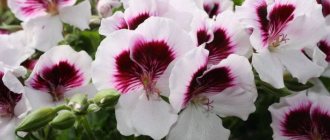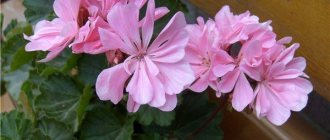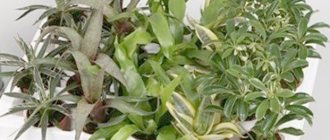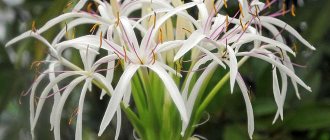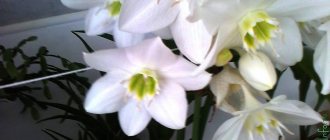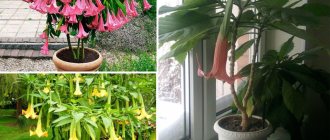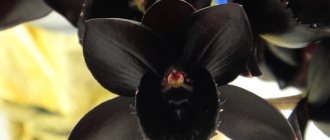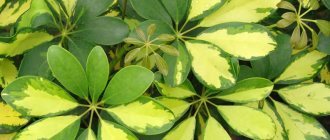Botanical description of the plant
The plant is popularly called royal geranium, although it belongs to the genus Pelargonium of the Geraniaceae family, subclass Rosidae. It has a lot of alternative names: domestic pelargonium, large-flowered, English, noble. It was bred artificially and came from closed-leaf pelargonium (cap geranium).
It is a potted plant but can grow into large bushes in mild climates. This geranium differs from other representatives in the shape and structure of the flower, as well as the splendor and arrangement of the inflorescences (not above the bush, but flush with the leaves). It blooms when it gets warm - from about April to August. The table below provides a brief description of the main morphometric parameters.
| Parameter | Description |
| Root system | fibrous |
| Stem | Erect, dense, almost completely hidden under the leaves |
| Leaf Shape | Simple, lobed, with a wavy, sometimes jagged edge |
| Leaf color | Greens |
| Flower shape | Large (usually from 4 to 7 cm), most often double, collected in umbrella-shaped inflorescences. Irregular, zygomorphic with only one plane of symmetry. The flower has a long nectar-bearing spur fused with the peduncle |
| Flower color | Varied: white, pink, red, lilac, maroon, purple. Characterized by dark veins and spots |
| Taste of Flowers | Bitterish, with a fruity minty note and rose aroma |
| Fruit shape | A long, narrow box with sepals, similar to the beak of a bird (hence “pelargos”, in Greek - “stork”) |
| Fruit color | Green, brown when ripe. |
When and how does it bloom
The flowering of royal geranium causes true delight among gardeners. She can not only look great, but also exude an amazingly subtle aroma.
Types of flowers
Royal geranium flowers can be not only classic, but also double. There are even specimens with corrugated inflorescences. The variety of their colors is simply amazing. The following shades can be presented:
- yellow;
- pink;
- red;
- violet;
- orange;
- white.
Royal geraniums have a rich range of colors
Flower shapes
The royal flower mostly has flat and concave petals on the inflorescences, but in some varieties they are wavy. This makes the plants even more attractive and sophisticated.
Flowering period
Unlike other varieties, royal geraniums do not have such a long flowering period. Its duration does not exceed six months. The beginning of flowering coincides with the onset of spring.
How to make it bloom at home
In order for royal geranium to bloom at home, its pot must be a little cramped. The plant also needs a period of rest. Otherwise, it will weaken and will not drown in flowers in the next season. Timely application of fertilizers, normalized watering and sufficient lighting levels are also necessary conditions for flowering.
Pruning for lush flowering
Before the onset of the dormant period, the main stem of royal geranium is shortened by a third of its length. This helps maintain the decorative appearance of the flower and also improves air circulation, which prevents the spread of fungi and pests.
Mandatory pruning is required for lush flowering.
Main varieties
Over centuries of cultivation, more than a thousand varieties have been bred, and their classification is quite confusing. Thus, flower growers do not agree on whether to classify the famous “angels” species, which appeared as a result of crossing royal and curly pelargoniums, as large-flowered, or whether to consider them a separate species. In addition, pelargoniums andy flowers, often classified as Pelargonium domesticum, were actually developed by crossing "angels" and royals.
Did you know? Geranium flowers are used in cooking. They are candied and added to compotes and desserts.
One way or another, most often there are several groups of these plants (the royal ones, “angels”, candy flowers), which differ from each other in the shape, size and color of the petals, as well as resistance to environmental influences. Each group includes many varieties. Let's look at the most popular of them.
Royal pelargoniums:
| Variety | Flower color, characteristic features |
| White Glory | White without veins or spots |
| Rimfire | Black and burgundy with dark veins |
| Margaret Soley | Large (6 cm) light red |
| Joy | Red-pink, reminiscent of primrose |
| Black Prince | Dark plum with silver edge |
Representatives of the “angels” group (fragile-looking mini-varieties with fragrant foliage and a short flowering period):
| Variety | Flower color, characteristic features |
| Spanish Angel | Purple, 3–3.5 cm in diameter |
| Imperial Butterfly | Quite large white with wine-red splashes, leaves with a citrus aroma |
| Tip Top Duet | The upper petals are dark crimson, the lower petals are pale lilac. Characterized by early and fairly long flowering |
| PAC Angeleyes Viola | White with splashes of pink, leaves with a citrus aroma. |
Representatives of the candy flowers group (hardy varieties that do well in open ground) include:
- light pink with dark spots Cambi (Bicolor);
- dark cherry Camred;
- Camdared with their petals colored bright red on the inside and a paler shade on the outside.
Did you know? One of the Angeleyes varieties is PAC Angeleyes Orange Paccrio, which has orange flowers and a carrot-like scent to the leaves.
general characteristics
Anyone who decides to seriously engage in this type of flowers will have to work hard, otherwise the expected result simply will not happen.
Truly “royal blood” actually flows in the stems and leaves of this type of geranium. Its homeland is South America, but this plant appeared in Europe only in the 8th century. It so happened that royal geranium achieved enormous popularity among flower growers in the shortest possible time. This plant is extremely interesting for breeders. As a result of their hard work, which does not stop literally for a minute, new varieties of royal pelargonium appear. Currently, there are such a large number of its varieties that it is quite difficult to name the exact number.
At home, pelargonium can reach a height of 60−80 cm. It is not worth growing bushes with a higher height, because the flowers are located only at the very top of the plant. If geranium grows to a height of 1 m, then it is characterized by the loss of all decorative properties. If you pursue only experimental goals, you can try to grow a bush up to 1.5 m high. Surrounded by low-growing plants, all the contrasting features will fully manifest themselves.
Conditions for successful growing at home
Royal pelargonium is quite finicky and requires special care and knowledge of the intricacies of cultivation. Otherwise, it simply will not bloom.
Lighting
Royal pelargonium loves light - without sufficient lighting it stretches in length, becomes unaesthetic and loses its immunity. Windows facing north or obscured by trees are not suitable for her. It is optimal to place the plant on the windowsills of south-facing windows, turning it several times a week at a slight angle relative to the window.
Important! Direct sunlight is dangerous for this type of geranium. In the summer, during hours when the sun is especially active, you can cover the windows with tracing paper or floral film.
Temperature
The temperature maximum in summer is 24 °C, in autumn the temperature begins to gradually decrease, and in winter, when buds are laid, it reaches 12–15 °C. To maintain this temperature regime, you can place the plant on an insulated terrace or balcony.
Air humidity
Avoid excessive dampness as this can cause fungal diseases. In addition, good ventilation is necessary to avoid stagnant air. At the same time, drafts are undesirable.
Geranium care
A royal plant requires royal treatment. You should start taking care of your plant from the minute you step into your own apartment. First of all, we decide on “registration”.
Where to put royal geranium
Paradox: royal geranium loves light, but does not like the sun.
She needs shading. But it cannot be placed deep into the room; without natural light, geranium leaves become smaller, the stems become elongated, and flowering is delayed indefinitely. And even if it comes, it will be very meager and short-lived. Of course, the best place is on the windowsill, but during the midday hours take care of protection from the sun. Burns on the leaves of royal geranium greatly spoil the appearance and slow down the development of the plant.
How to water and feed royal geraniums
White beauty
Opinions among flower growers are divided: some recommend watering through a tray. In this case, the plant itself must regulate the amount of water it needs. Others use traditional root watering, but in any case the water should be settled and at room temperature, or preferably 2-3° more, temperature.
You can use cooled boiled water. A dry top layer of soil in a flower pot warns of the need for watering, but do not forget that excess moisture is the cause of fungal diseases.
In early spring, when the plant “wakes up,” it will need additional strength. The application of nitrogen-containing fertilizers will come in handy. This will be followed by phosphorus-potassium fertilizing - they will ensure lush and long-lasting flowering. The feeding period lasts from March to September. Later, the plant will begin to prepare for the dormant period.
Home care
Having provided the necessary conditions of detention, you can begin care measures.
Learn how to care for geraniums in winter.
Watering
The watering schedule depends on the time of year. In summer, it is necessary to water abundantly 2 times a day with settled water at room temperature, but do not overdo it: stagnation of water is unacceptable. Royal pelargonium does not require spraying the leaves with water. For watering, experienced gardeners recommend using a tray, then the geranium itself absorbs the required amount of water with its roots. In winter, watering is reduced.
Top dressing
Feed during watering once every 2 weeks with special liquid complexes for ornamental plants (nitrogen-potassium-magnesium), at the beginning of the growing season introducing additional potassium for better bud formation. The popular method of feeding is to dilute a drop of iodine in a liter of water and carefully pour this solution over the walls of the pot. You should not overdo it with fertilizing - this will lead to burns and yellowing of the foliage.
How and when to prune
Flower growers who have not previously dealt with royal geraniums traditionally (and mistakenly) prune them in the spring, but this can lead to improper formation of shoots. The best time for pruning in this case is the beginning of September. For lush flowering and less trauma to the noble plant, pruning should be carried out in 2 stages.
The interval between procedures is about a month. First, dry and excess stems (about a third) are removed, and in the second stage, the formed young shoots are pinched, stimulating the active growth of new ones. When pruning, you must remember to use a disinfected tool and treat the cuts with activated carbon.
Read more about pruning geraniums for the winter.
Transfer
To maintain the decorative properties of geraniums, it is recommended to replant them every 2–3 years. It occurs when the plant's roots begin to poke through the drainage hole. The optimal time is from late January to March, when geranium wakes up after wintering, but is not yet preparing to bloom. A pot that is not too spacious is used, otherwise all the growth will go into greenery and there will be no flowers.
Recommended reading
How and when should you replant indoor plants?
The transplant process occurs as follows:
- Geranium is watered generously to make it easier to remove from the pot.
- The plant is removed along with a lump of earth and placed in a new pot.
- The voids between the container and the plant are filled with moistened soil (peat and sand or peat and perlite mixed in equal proportions).
- At the bottom of the pot you definitely need drainage holes and a layer of expanded clay or small pebbles.
How does grandiflora reproduce?
Royal pelargonium can be propagated in different ways: by seeds, cuttings and air layering. Each of them has certain features, so you should familiarize yourself with them.
Seeds
Zephyranthes - flower care at home
This method is the most labor-intensive and time-consuming, but it allows you to obtain a large number of new seedlings. In this case, you can purchase planting material of one variety and mixes.
Seeds should be sown in a moist soil mixture of turf, peat and sand in a ratio of 2:1:1 to a depth of 0.5 cm. After this, the container should be placed in a bright place with a temperature of +22..+26 degrees. The first shoots appear after 2 weeks.
Cuttings
The vegetative method is considered the simplest. It should be used in spring and summer.
For propagation, it is necessary to cut apical cuttings with 3-5 leaves. Then dry the lower cut for 2-3 hours, and only then powder it with root-forming agent and plant it in soil consisting of turf, sand and peat in equal proportions.
For successful rooting, it is recommended to keep the soil constantly slightly moist and the temperature within +22..+25 degrees.
Note! Cuttings take root in 3-4 weeks.
Grandiflora cuttings allow you to obtain strong seedlings
Air layering
To propagate pelargonium in this way, it is necessary to measure the length of the cutting from the top of the shoot and make an oblique cut deep into 1/3 of its width. Then powder the cut with any root-forming agent and put a piece of match inside to prevent tissue fusion.
Then, a little below the cut, you need to make a cuff from a film and put wet sphagnum moss inside. In such an environment, roots form after 2 weeks. After this, the cuttings need to be cut 1.5 cm below the cuff and planted in the usual soil mixture.
Features of care in winter
Geranium spends the autumn-winter period in hibernation, which determines the specifics of caring for it in the cold:
- For sufficient lighting, fluorescent phytolamps are used.
- The air temperature drops to the already mentioned 12–15 °C.
- Mineral feeding is stopped.
- If geranium was planted in the garden for the summer (this is most often practiced with varieties of candy flowers), it is not left there for the winter, especially in the middle zone.
- Watering is reduced, focusing on the condition of the earthen clod - it should not be dry.
Which geranium cuttings are best for planting?
Young (non-lignified) shoots from both the top and the middle part of the stem, which are cut with a knife at an oblique angle just below the node, are suitable for propagation. The best shoot is one that receives more sun.
The ideal cutting length is 8-10 cm. The ideal number of internodes is three. The lower leaves of the cuttings are removed. Large upper leaves are cut in half, if there are a lot of them, pluck out every second one. And the cuttings are left alone for 2-4 hours to dry the cut.
Reproduction
All flower growers are interested in the issue of propagating royal pelargonium, because such beautiful flowers necessarily require reproduction. There are two methods of reproduction, which have their advantages and disadvantages.
You will be interested to know about propagating royal geranium at home.
Cuttings
It is produced by rooting cuttings, which are taken no earlier than the end of January - then the level of growth hormone increases, but no later than March - bud formation begins in the spring. It is recommended to immediately use separate pots with drainage holes. After cutting, the edges of the cuttings are treated with activated carbon powder, dried and planted in the ground (the same mixture is used as for replanting).
Young plants are kept in a moderately warm room (19–22 °C), not forgetting about watering, and fed with mineral complexes with a reduced nitrogen content twice a month (so that fewer leaves grow and more flowers). Pinching (removal of apical buds) is done for the first time after a few weeks over the third pair of leaves and stops when the pelargonium acquires the shape and bushiness desired by the owner.
Growing from seeds
Propagation by seeds is not a very successful method for this particular type of geranium, primarily because it is difficult to find high-quality seeds in domestic stores. In addition, with this type of propagation, such a trait as the doubleness of flowers is almost not transmitted.
If the grower still decides to sow Pelargonium domesticum, it is better to do it in winter. The air temperature in the room should be at least 20 °C, the soil in the box with seedlings should be kept moist. Shoots usually appear in the 3rd week. After this, the seedlings are transferred to a temperature regime of 15 ° C and, when the first leaves appear, they are planted in pots, not forgetting about tweezing.
Diseases and pests of geranium
Royal geranium, however, like any other plant, can suffer from various diseases and pests. It gets sick infrequently, subject to the rules of agricultural technology. Otherwise, it is subject to the following ailments.
Gray rot. The disease occurs when pelargonium is grown in soils with excess nitrogen and excess moisture. Brown spots and a gray coating appear on all parts of the plant. First aid for a flower consists of transplanting the plant into new soil, with parallel treatment with fungicides. (“Vitaros”, “Fundazol”.)
Rot: root and stem. The first sign of damage may be the presence of dark spots at the base of the stem. The leaves become withered, begin to turn yellow and eventually fall off. And the reason lies in waterlogging of the soil and low acidity levels. For treatment use “Binoram” or “Fitolavin”.
Late blight. Very often the disease is transmitted through the soil, but excessive moisture can also be a cause. In addition, the infection can be transferred by draft from one flower to another. The leaves begin to turn yellow, and pockets of rot with a gray coating appear.
Diseased parts of the plant are removed, and the cut areas are sprinkled with crushed coal. For treatment, Bordeaux mixture is used, and the plant itself, after treatment, is transplanted into sterile soil and the same sterile pot.
Weak plants are most susceptible to attack by pests. For royal geraniums, mites, whiteflies, and aphids pose a danger. If danger has just appeared, the plant is treated with a solution of green soap and, if possible, isolated from neighbors in the flower garden.
In case of serious damage, serious measures are taken. To destroy pests, the preparations “Marathon”, “Zubr”, “Monterey” are used.
Difficulties in growing
As we have already seen, caring for noble pelargonium has many nuances, failure to comply with which leads to diseases and pest damage. Let's look at possible problems and how to deal with them.
Find out what to do if geraniums don't bloom.
Doesn't bloom
The most common question that worries gardeners is: why does pelargonium not bloom even with seemingly proper care and what to do about it. You can answer it like this:
- One reason may be the composition of the soil. If the soil is exclusively peaty, then it does not allow air to pass through well and retains moisture too much. Therefore, the soil must contain sand.
- Very often, owners of pelargoniums literally flood them with water, which cannot be done, as this causes the leaves to turn yellow and flowering stops.
- Too large, spacious pots allow the development of the root system to the detriment of flowering.
- Pest infestation also negatively affects decorative functions.
Diseases
The most common disease to which these plants are susceptible is blackleg. The reasons for it lie in infection with the Pythium fungus due to improper care: too cold a room, large pots, excessive watering. A characteristic sign is blackening of the stems.
It is practically useless to treat the plant; it is better to take care of its re-rooting. Yellowed foliage can be a sign not only of too much watering, but also, paradoxically, of insufficient watering, small pot sizes, small or, conversely, excessive amounts of fertilizing.
Important! Freshly planted cuttings are most susceptible to blackleg, so under no circumstances should they be covered with polyethylene, thus creating a wet bath effect that is beneficial for the fungus.
Pests
The main winged enemy of pelargoniums is the whitefly, which looks like a tiny white butterfly. Yellow spots on the leaves usually indicate a whitefly infestation. At the initial stage, you can try to wash off the midges from the plant with a damp cotton swab, but the classic method of control is to water the soil three times (at weekly intervals) with Aktara.
Caring for noble pelargonium differs in many ways from caring for other members of the genus. To understand how to make royal geraniums bloom, you need to remember and follow the nuances associated with watering, pruning and disease prevention discussed in the article.
Features of plant flowering
Asplenium nidus: examples of main varieties and conditions for flowering in the house
Royal geranium blooms for quite a long time. A healthy plant, with proper care, will delight its owner with large, beautiful flowers from spring to late summer. It was the unsurpassed flowers of this plant that gave it the status of royal.
Compliance with the activity and rest regime of royal geranium is extremely important. If in winter almost all manipulations with the plant end, and the pot itself is even put away in a dark place, then in summer it is important to carry out regular processing.
After the geranium emerges from dormancy, light pruning is carried out and a period of fertilizing and moistening begins. This is the only way to expect beautiful double buds during the flowering period.
Geranium flowers usually look like spherical umbrellas. The inflorescences are located on long and thin stems; sometimes it seems that the shoots simply cannot stand such flowers. The color of the inflorescences can be very diverse. There are white and even dark purple shades.
Varieties of indoor plants with names and what they look like
Royal geranium - home care for beginners
Depending on the variety, you can get pelargonium of various colors. Each variety evokes special admiration among gardeners, and therefore, despite the difficult nature of the flowers, many lovers want to purchase a royal specimen for their home.
"Mandarin"
The fiery red or orange flowers of the royal pelargonium variety Mandarin often exceed 6 cm in diameter. In the middle, the color fades noticeably to a creamy white color. Thin purple stripes run from the core to the edges of the petals. The flower is semi-double with wavy edges.
Mandarin
"Mona Lisa"
Early flowering variety. Large white flowers have crimson spots in the core. The edges of the petals are wavy. It blooms for a long time, compared to other varieties. The inflorescences reach a diameter of 5 cm.
Mona Lisa
"Morvena"
The plant is quite compact with large burgundy-black inflorescences that look beautiful against the background of bright green foliage. The plant blooms for a long time, grows well, while maintaining its decorative properties.
Morwena
"Elegance Jeanette"
Another early variety of the royal species of pelargonium-grandiflora. Elegance Janet has large flowers, they are lilac-pink with darker spots. The variety is quite compact, green leaves, blooms in the cold season for 1.5 months.
Elegance Jeanette
"Clerion Bright Red"
The variety belongs to the variety of royal pelargonium multiflora. The flowers are medium-sized, curly, cherry-red with a black spot at the base of the petals.
The variety blooms profusely and for a long time, and does not require cool maintenance in winter, since it blooms in the summer.
Clerion bright ed
Appearance and features
After some time, the lower part of the pelargonium becomes woody, turning it into a compact, neat bush.
The foliage has different color shades. Most often - light green and dark green. They are round in shape, with teeth along the edges.
A distinctive feature of Grandiflora is its luxurious, large flowers. Their diameter can reach 6 centimeters. There are similarities with pansies. The color is very diverse: soft pink, bright red, purple and many other shades of these colors. The flower stalks are at the same level as the leaves. Due to this feature, the plant looks like a spectacular ball.
Pelargonium’s inflorescences collected in dense umbrellas give the external attractiveness and decorativeness. The bush itself does not exceed 30 centimeters in height. Mainly growing in width.
